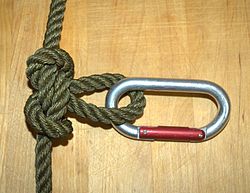(+trans) |
(Marked this version for translation) |
||
| Line 1: | Line 1: | ||
| − | <noinclude><translate></noinclude> | + | <noinclude><translate><!--T:1--> |
| + | </noinclude> | ||
{{Knot | {{Knot | ||
| name = Alpine butterfly | | name = Alpine butterfly | ||
| Line 7: | Line 8: | ||
| use = The Butterfly Loop has a high breaking strength and is regarded by mountaineers as one of the strongest knots to attach climbers to the middle of a rope, such that they have room to move around even when the main rope goes tight, and they can be supported in either direction from the main rope. The loop is typically attached to a climbing harness by carabiner. | | use = The Butterfly Loop has a high breaking strength and is regarded by mountaineers as one of the strongest knots to attach climbers to the middle of a rope, such that they have room to move around even when the main rope goes tight, and they can be supported in either direction from the main rope. The loop is typically attached to a climbing harness by carabiner. | ||
| + | <!--T:2--> | ||
It can also be used to isolate a worn section of rope, where the knot is tied such that the worn section is used for the center of the loop. | It can also be used to isolate a worn section of rope, where the knot is tied such that the worn section is used for the center of the loop. | ||
}} | }} | ||
Revision as of 03:38, 6 November 2014
| Alpine butterfly |
|---|
|
Use: The Butterfly Loop has a high breaking strength and is regarded by mountaineers as one of the strongest knots to attach climbers to the middle of a rope, such that they have room to move around even when the main rope goes tight, and they can be supported in either direction from the main rope. The loop is typically attached to a climbing harness by carabiner.
It can also be used to isolate a worn section of rope, where the knot is tied such that the worn section is used for the center of the loop.
|


